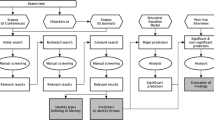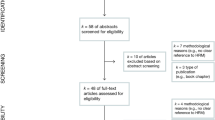Abstract
Even though there is abundant literature on successful cases of organizations applying knowledge management (KM) measures, many KM initiatives have failed to achieve their knowledge and business goals. In order to foster decisions about the design of such initiatives, information is required on success factors and barriers when selecting KM measures. Multi agent-based simulation (MABS) is suggested as instrument to investigate potential effects of KM measures on dependent variables such as sharing of knowledge in organizations or business performance. For such a simulation, the concept of knowledge sharing, influencing factors and their impact on business and knowledge goals are modeled based on an extensive multi-disciplinary literature survey. An extensive domain model is operationalized in a simulation model which is then further simplified and implemented in a MABS tool used for a series of experiments contrasting results with/without KM measures, specifically skill and experience management. Skill management is found highly sensitive with respect to conditions of application and has no significant impact on knowledge or business goals. Experience management positively impacts knowledge and business goals. Personal documentation leads to specialist, project debriefings to generalist knowledge workers. Finally, the paper discusses the simulation’s limitations and further areas of application.




Similar content being viewed by others
Notes
For simplicity reasons, in all functions only the utility is shown instead of expected utility as used in the original work.
Meyer, A. (2002/2003/ 2004): Wer verdient wie viel? Ergebnisse der c’t-Gehaltsumfrage. c’t magazin für computer und technik (06), 110–119/118–127/106–113.
Krischer, T., IG-Metall (2003/2004): Entgelt in der IT-Branche. 5./6. Erhebung, IG-Metall, Frankfurt a.M., Germany.
Uneven numbers result from the design with 1 CEO, X project managers and 3*X software developers.
Skill is calculated as the sum of knowledge of an agent with respect to the four domains.
References
Alavi, M., & Leidner, D. E. (2001). Review: knowledge management and knowledge management systems: conceptual foundations and research issues. Management Information Systems Quarterly, 25(1), 107–136.
Alvesson, M. (2004). Knowledge work and knowledge-intensive firms. Oxford: Oxford University Press.
Anderson, J. R. (1976). Language, memory, and thought. Hillsdale: Erlbaum.
Anderson, J. R. (1996). ACT—a simple theory of complex cognition. American Psychologist, 51, 355–365.
Anjewierden, A., Shostak, I., & de Hoog, R. (2002). KMsim—a meta-modelling approach and environment for creating process-oriented knowledge management simulations, 13th European Conference on Knowledge Acquisition, Management and Modelling (EKAW), Sigüenza, 65–79.
Argote, L., et al. (2000). Knowledge transfer in organizations—learning from the experience of others. Organizational Behavior and Human Decision Processes, 82(1), 1–8.
Berends, H., van der Bij, H., Debackere, K., & Weggeman, M. (2004). Knowledge sharing mechanisms in industrial research, Working Paper 04.04, Eindhoven Centre for Innovation Studies, Eindhoven.
Berends, H., van der Bij, H., Debackere, K., & Weggeman, M. (2006). Knowledge sharing mechanisms in industrial research. R&D Management, 36(1), 85–95.
Bishop, J., Bouchlaghem, D., Glass, J., & Matsumoto, I. (2008). Ensuring the effectiveness of a knowledge management initiative. Journal of Knowledge Management, 12(4), 16–29.
Boer, N.-I., & Berends, H. (2003). The relational dimension of knowledge sharing—an empirical study of an industrial research group, 4th European Conference on Organizational Knowledge, Learning and Capabilities (OKLC 2003), Barcelona, Spain.
Boer, N.-I., van Baalen, P. J., & Kumar, K. (2002). An activity theory approach for studying the situatedness of knowledge sharing. 35th Hawaii International Conference on System Sciences (HICSS 2002). 2002. Big Island, Hawaii.
Canals, A., Boisot, M., & MacMillan, I. (2004). Evolution of knowledge management strategies in organizational populations: a simulation model. IN3-UOC Working Paper Series, WP04-007.
Carley, K. M. (1992). Organizational learning and personnel turnover. Organization Science, 3(1), 20–46.
Carley, K. M. (2002). Information technology and knowledge distribution in C3I teams. Command and Control Research and Technology Symposium. 2002. Naval Postgraduate School, Monterey, CA.
Clancey, W. J. (1997). Situated cognition—on human knowledge and computer representation. Cambridge: Cambridge University Press.
Cohen, D. (1998). Toward a knowledge context—report on the First Annual U.C. Berkeley forum on knowledge and the firm. California Management Review, 40(3), 22–39.
Cowan, R., & Jonard, N. (2004). Network structure and the diffusion of knowledge. Journal of Economic Dynamics & Control, 28(8), 1557–1575.
Davenport, T. H., Probst, G. J. B. (2002). Knowledge management case book. Best Practises, 2nd ed., Erlangen.
Davenport, T. H., Jarvenpaa, S. L., & Beers, M. C. (1996). Improving knowledge work processes. Sloan Management Review, 37(4), 53–65.
Dervisoglua, G., & Berberb, A. (2004). Knowledge flow during the product development process and role of the mediator—a model presentation. 37th Hawaii International Conference on System Sciences (HICSS 2004), Big Island, Hawaii.
Dreyfus, H. (2002). A phenomenoloy of skill acquisition as the basis for a Merleau-Pontian non-representationalist cognitive science, International Conference Foundations and the Ontological Quest. Prospects for the New Millenium, Rome, Pontifical Lateran University.
Drucker, P. F. (1994). The age of social transformation. The Atlantic Monthly, 274(5), 53–80.
Elliman, T., Eatock, J., & Spencer, N. (2005). Modelling knowledge worker behaviour in business process studies. Journal of Enterprise Information Management, 18(1), 79–94.
Engeström, Y. (2000). Activity theory and the social construction of knowledge—a story of four Umpires. Organization, 7(2), 301–310.
Fayol, M. (1994). From declarative and procedural knowledge to the management of declarative and procedural knowledge. European Journal of Psychology of Education, 9(3), 179–190.
Fiske, A. P. (1991). Structures of social life—the four elementary forms of human relations. New York: Free Press.
Gobet, F., Lane, P. C. R., Croker, S., Cheng, P. C. H., Jones, G., Oliver, I., et al. (2001). Chunking mechanisms in human learning. Trends in Cognitive Sciences, 5(6), 236–243.
Graefe, G. (2003). Incredible information on the internet—biased information provision and a lack of credibility as a cause of insufficient information quality, 8th International Conference on Information Quality (ICIQ 2003), Cambridge, MA.
Hanakawa, N., Matsumoto, K.-I., & Torii, K. (2002). A knowledge-based software process simulation model. Annals of Software Engineering, 14, 383–406.
Hansen, M. T., Nohria, N., & Tierney, T. (1999). What’s your strategy for managing knowledge? Harvard Business Review, 77(3–4), 106–116.
Holsapple, C. W. (Ed.). (2003). Handbook on knowledge management, vol. 1+2. Berlin: Springer.
Holsapple, C. W., & Joshi, K. D. (2000). An investigation of factors that influence the management of knowledge in organizations. Journal of Strategic Information Systems, 9(2–3), 235–261.
Inuzuka, A. (2003). How to share knowledge effectively? In T. Terano, H. Deguchi, & K. Takadama (Eds.), Meeting the challenge of social problems via agent-based simulation (pp. 123–137). Tokio: Springer.
Laird, J. E., Newell, A. F., & Rosenbloom, P. S. (1986). Chunking in soar—the anatomy of a general learning mechanism. Machine Learning, 1(1), 11–46.
Lang, J., van der Torre, L., & Weydert, E. (2000). Utilitarian desires. Autonomous Agents and Multi-Agent Systems, 5(3), 329–363.
Lethbridge, T. C. (1999). The relevance of education to software practitioners—data from the 1998 Survey, Technical Report TR-99-06, School of Information Technology and Engineering, University of Ottawa.
Maier, R. (2007). Knowledge management systems—information and communication technologies for knowledge management (3rd ed.). Berlin: Springer.
Maier, R., Thalmann, S., Bayer, F., Krüger, M., Nitz, H., & Sandow, A. (2008). Optimizing assignment of knowledge workers to office space using knowledge management criteria—the flexible office case. Journal of Universal Computer Science, 14(4), 508–525.
Maier, R., Hädrich, T., & Peinl, R. (2009). Enterprise knowledge infrastructures (2nd ed.). Berlin: Springer.
Martinez-Miranda, J., & Aldea, A. (2002). A social agent model to simulate human behaviour in teamwork, 3rd Workshop on Agent-Based Simulation, Passau, 18–23
Meredith, R., & Burstein, F. (2000). Getting the message across with communicative knowledge management. Australian Conference on Knowledge Management and Intelligent Decision Support (ACKMIDS), Monash University, Australia.
Mi, P., & Scacchi, W. (1990). A knowledge-based environment for modeling and simulating software engineering processes. IEEE Transactions on Knowledge and Data Engineering, 2(3), 283–294.
Moreno, A., Valls, A., & Marín, M. (2003). Multi-agent simulation of work teams, 3rd International/Central and Eastern European Conference on Multi-Agent Systems, CEEMAS, Prague, Czech Republic, 281–291.
Müller, J. P. (1996). The design of intelligent agents—a layered approach. Berlin: Springer.
Nissen, M. E. (2002). An extended model of knowledge-flow dynamics. Communications of the Association for Information Systems, 8, 251–266 (online).
Nissen, M. E. (2006). Harnessing knowledge dynamics: Principled organizational knowing & learning. Hershey: IRM Press.
Nissen, M. E., & Levitt, R. E. (2004). Agent-based modeling of knowledge flows: Illustration from the Domain of Information Systems Design, 37th Hawaii International Conference on System Sciences (HICSS 2004), Big Island, Hawaii.
Nissen, M. E., Kamel, M., & Sengupta, K. (2000). Integrated analysis and design of knowledge systems and processes. Information Resources Management Journal, 13(1), 23–43.
Nonaka, I. (1991). The knowledge-creating company. Harvard Business Review, 69(11–12), 96–104.
Nonaka, I. (1994). A dynamic theory of organizational knowledge creation. Organization Science, 5(1), 14–37.
Paauwe, J. (2004). HRM and performance—achieving long term viability. New York: Oxford University Press.
Peinl, R. (2008). Multiagentensimulation der Wissensweitergabe in Organisationen am Beispiel von Individualsoftwareherstellern, PhD Thesis, Martin Luther University Halle-Wittenberg, Germany.
Petre, M., & Blackwell, A. F. (1997). A glimpse of expert programmers’ mental imagery. 7th Workshop on Empirical studies of programmers, Alexandria, VA, 109–123.
Pinder, C. C. (1998). Work motivation in organizational behavior. Upper Saddle River: Prentice Hall.
Polanyi, M. (1966). The Tacit Dimension, London.
Probst, G., Raub, S., Romhardt, K. (1998). Wissen managen: Wie Unternehmen ihre wertvollste Ressource optimal nutzen, 2nd edition, Wiesbaden.
Rao, A. S., & Georgeff, M. P. (1995). BDI agents: from theory to practice. Technical Note 56, Australian Artificial Intelligence Institute.
Rich, E. H., & Duchessi, P. (2004). Modeling the sustainability of knowledge management programs, 37th Hawaii International Conference on System Sciences (HICSS 2004), Big Island, Hawaii.
Rubinstein, A. (2002). Modeling bounded rationality, 3rd print. Cambridge: MIT Press.
Ruthruff, E., Remington, R. W., & Johnston, J. C. (2001). Switching between simple cognitive tasks: the interaction of top-down and bottom-up factors. Journal of Experimental Psychology: Human Perception and Performance, 27, 1404–1419.
Shostak, I., Anjewierden, A., de Hoog, R. (2002). Modelling and Simulating Process-Oriented Knowledge Management, Proceedings of the 3rd European Conference on Knowledge Management (ECKM), Dublin, Ireland, S. 634–648.
Song, M., van der Bij, H., & Weggeman, M. (2003). An empirical investigation into the antecedents of knowledge dissemination at the strategic business unit level. Journal of Product Innovation Management, 20(2), 163–179.
Squire, L. R. (1987). Memory and brain. New York: Oxford.
Starbuck, W. H. (1992). Learning by knowledge-intensive firms. Journal of Management Studies, 29(6), 713–740.
Steers, R. M., Mowday, R. T., & Shapiro, D. L. (2004). The future of work motivation theory. Academy of Management Review, 29(3), 379–387.
Sveiby, K.-E., & Lloyd, T. (1987). Managing knowhow. London: Bloomsbury Publishing.
Szulanski, G. (1996). Exploring internal stickiness: Impediments to the transfer of best practice within the firm, in: Strategic Management Journal, Vol. 17, 1996, Winter Special Issue, 27–43.
Thomas-Hunt, M. C., Ogden, T. Y., & Neale, M. A. (2003). Who’s really sharing? Effects of social and expert status on knowledge exchange within groups. Management Science, 49(4), 464.
Tsai, W. (2001). Knowledge transfer in intraorganizational networks—effects of network position and absorptive capacity on business unit innovation and performance. Academy of Management Journal, 44(5), 996.
Tsui, E. (2005). The role of IT in KM: where are we now and where are we heading? Journal of Knowledge Management, 9(1), 3–6.
Turner, S. F., Bettis, R. A., & Burton, R. M. (2002). Exploring depth versus breadth in knowledge management strategies. Computational & Mathematical Organization Theory, 8(1), 49–73.
Urban, C., & Schmidt, B. (2001). PECS—agent-based modelling of human behaviour, emotional and intelligent II—the tangled knot of social cognition, AAAI Fall Symposium 2001, North Falmouth, MA.
Wang, J., Gwebu, K., Shanker, M., & Troutt, M. D. (2009). An application of agent-based simulation to knowledge sharing. Decision Support Systems, 46, 532–541.
Wiig, K. M. (1988). Management of knowledge: perspectives of a new opportunity. In: T. Bernold (Ed.), User interfaces: gateway or bottleneck? Proceedings of the Technology Assessment and Management Conference of the Gottlieb Duttweiler Institute Rüschlikon/Zurich (CH), 20–21 October, 1986, Amsterdam, 101–116.
Wolff, E. N. (2005). The growth of information workers. Communications of the ACM, 48(10), 37–42.
Author information
Authors and Affiliations
Corresponding author
Rights and permissions
About this article
Cite this article
Peinl, R., Maier, R. SimKnowledge—Analyzing impact of knowledge management measures on team organizations with multi agent-based simulation. Inf Syst Front 13, 621–636 (2011). https://doi.org/10.1007/s10796-010-9241-5
Published:
Issue Date:
DOI: https://doi.org/10.1007/s10796-010-9241-5




